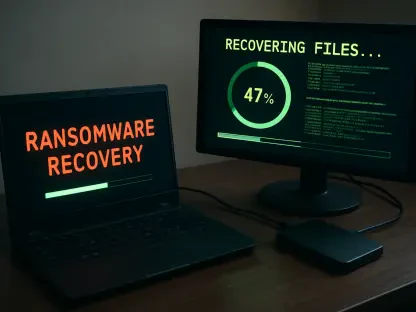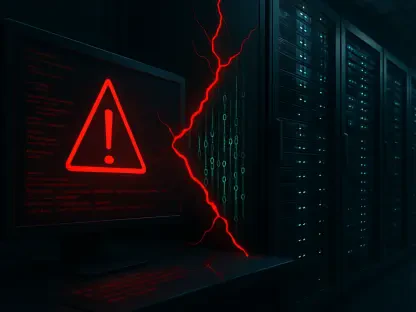What happens when a titan of internet security, tasked with shielding millions of websites from cyber threats, turns its own weapons inward? On a fateful day in September, Cloudflare, a linchpin of online infrastructure, stumbled into a staggering crisis of its own making, revealing a surprising fragility in a company built to prevent such chaos. A tiny coding error spiraled into a self-inflicted Distributed Denial of Service (DDoS) attack, knocking out critical systems for over an hour. This wasn’t the work of a malicious hacker but an internal blunder that exposed vulnerabilities. The incident sent shockwaves through the tech world, raising urgent questions about the reliability of even the most trusted guardians of the internet.
Why This Tech Mishap Shakes Confidence
The significance of Cloudflare’s outage extends far beyond a temporary glitch. As a provider that supports roughly 20% of the world’s top websites, according to industry estimates, its services are the backbone for countless businesses, from e-commerce giants to media platforms. When its dashboard and APIs crumbled under self-generated pressure, the disruption rippled across industries, halting operations and frustrating users globally. This event underscores a stark reality: even companies at the forefront of cybersecurity aren’t immune to catastrophic errors. It’s a potent reminder that the internet’s foundation, often taken for granted, can crack under the weight of a single misstep.
This isn’t merely about one company’s stumble; it’s a broader cautionary tale for an era where digital dependency is at an all-time high. With cyber threats evolving and internet traffic surging—projected to grow by 30% annually from 2025 to 2027 per recent studies—such incidents highlight the urgent need for robust safeguards. The fallout from Cloudflare’s error serves as a wake-up call, pushing tech leaders and developers to rethink how they build and protect critical systems.
The Fatal Flaw: A Coding Error Unleashed Chaos
Digging into the root of the disaster reveals a deceptively simple mistake with devastating consequences. At the core was a misused React useEffect hook within Cloudflare’s dashboard code, a tool meant to manage side effects in web applications. Due to a flawed setup, the hook’s dependency object refreshed with every minor update, triggering an endless loop of API calls that bombarded the system.
The primary victim of this barrage was the Tenant Service API, a crucial component for authorizing requests. Unable to handle the relentless flood of calls, it buckled under the strain, dragging down not just the dashboard but multiple interconnected APIs. What should have been a routine function turned into a digital avalanche, exposing how a minor oversight in code can cripple even the most fortified infrastructure.
For over an hour, services ground to a halt, leaving users and dependent businesses in limbo. This wasn’t a sophisticated external attack but an internal coding misstep, proving that sometimes the greatest threats come from within. The incident laid bare a critical gap in testing and oversight, challenging assumptions about the invincibility of tech giants.
Behind the Scenes: A Struggle to Diagnose Disaster
Unraveling the mess proved to be a daunting task for Cloudflare’s team. Tom Lianza, the company’s VP of Engineering, described the diagnostic process as grueling, with the sheer volume of API overload masking the true culprit—a hidden loop in the dashboard’s code. The complexity of the issue delayed a swift resolution, amplifying the outage’s impact as engineers scrambled to pinpoint the source.
Beyond internal challenges, the incident sparked a firestorm of reactions from the tech community. On platforms like Reddit, developers debated fiercely over the React useEffect hook’s role. Some praised it as an indispensable tool, arguing that proper implementation avoids such pitfalls, while others criticized its frequent misuse, with one commenter noting, “A DDoS protector tripping over its own code is peak irony.” These contrasting views reflect a deeper tension in the industry about balancing powerful tools with disciplined practices.
Adding to the discourse, React’s official documentation has long cautioned against performance issues with useEffect, a warning that went unheeded in this case. The struggle to diagnose and the community’s split opinions highlight a critical need for better education and stricter protocols when deploying complex features in high-stakes environments.
Ripple Effects: How Businesses Felt the Sting
The outage’s impact wasn’t confined to Cloudflare’s servers; it reverberated through the vast network of businesses relying on its infrastructure. Small startups and large enterprises alike found their operations stalled, with dashboards inaccessible and API-dependent services frozen. For many, this translated into lost revenue and frustrated customers, a stark illustration of how interconnected the digital economy has become.
A case in point is a mid-sized e-commerce platform that reported a 40% drop in transactions during the outage window, as shared in industry forums. Such disruptions expose the hidden cost of dependency on centralized services, where a single point of failure can cascade into widespread chaos. Businesses, often unaware of the intricate systems behind their online presence, were left grappling with the fallout of an error they couldn’t foresee or control.
This incident also reignited debates about diversifying infrastructure reliance. Companies are now prompted to consider backup solutions or multi-provider strategies to mitigate risks. While Cloudflare’s scale offers unmatched protection under normal circumstances, this event revealed that no system is foolproof, urging a reevaluation of trust placed in singular tech providers.
Turning Lessons into Action: Preventing the Next Collapse
From this debacle, clear lessons emerge for developers and tech companies aiming to avoid similar catastrophes. First, a deep understanding of tools like useEffect is non-negotiable—limiting dependency updates through careful coding can prevent unintended loops. Cloudflare’s oversight in this area serves as a stark warning to prioritize precision over haste in development.
Equally critical is the need for robust API stress testing. Cloudflare has since bolstered the Tenant Service’s capacity to handle sudden spikes, a move that should have been proactive rather than reactive. Regular simulations of high-traffic scenarios can expose weaknesses before they become crises, a practice that must become standard across the industry.
Finally, enhanced monitoring and a culture of rigorous code review are vital. Cloudflare’s improved tracking now distinguishes between legitimate requests and retries, a change that could have flagged the issue sooner. Encouraging meticulous testing, especially for systems supporting millions, transforms potential disasters into manageable hiccups. These steps, while spurred by a painful lesson, offer a roadmap for building resilience in an increasingly complex digital landscape.
Reflecting on a Digital Wake-Up Call
Looking back, Cloudflare’s self-inflicted outage stood as a humbling moment for a company synonymous with internet security. It revealed that even the most formidable defenders could falter under the weight of their own errors, leaving a lasting imprint on how the tech world viewed reliability. The incident, driven by a misused coding tool and insufficient safeguards, became a pivotal case study in the fragility of digital systems.
The aftermath pushed a vital conversation about balancing innovation with caution, compelling developers to approach powerful tools with greater care. It also underscored the necessity of capacity planning for critical APIs, a lesson that resonated across industries. As a direct result, many in the field adopted stricter protocols and testing measures to fortify their systems.
Moving forward, the tech community was urged to treat such mishaps as opportunities for growth. Prioritizing proactive monitoring, fostering meticulous coding habits, and diversifying infrastructure dependencies emerged as key strategies to prevent future disruptions. This event, though a setback, paved the way for stronger, more resilient digital frameworks, ensuring that the internet’s backbone could withstand even the most unexpected internal threats.









